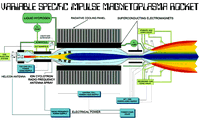I recently presented a possible solution to the problem of UNSC ships simply hovering in mid-air in my blog I believe I can fly... Now that we've gotten that annoying scientific blunder out of the way, I believe that the time is ripe to speculate on UNSC sublight engine technology.
I've read on various pages that the UNSC uses chemical thrusters for propulsion in space. This isn't totally wrong: Emergency thrusters work by explosively reacting Hydrogen Peroxide and some totally made-up substance called Trihydride tetrazine, but these are for rapid course changes and can only be used once, and I find it astounding that a society that can cross dozens of light years in mere days and modify and enhance human beings is still using inefficient chemical rockets.
After several internet searches, I came up with three engine designs that I felt would be within the UNSC's technological level.
1: VASIMR[]
The Variable Specific Impulse Magnetoplasma Rocket uses radio waves to ionize a propellant and magnetic fields to accelerate the resulting plasma to generate thrust. What it does is pump gas through what is essentially a microwave oven, turning it into plasma, energises the plasma via further RF heating in an ICRF booster, before using electromagnets create a magnetic nozzle to convert the plasma's built-up thermal energy into kinetic force.

VASIMR diagram.
VASIMR would be a great deep-space propulsion system. By varying the amount of energy dedicated to RF heating and the amount of propellant delivered for plasma generation VASIMR would be capable of either generating low-thrust, high-specific impulse exhaust or relatively high-thrust & low-specific impulse exhaust (Specific impulse is a bit like miles per gallon for a rocket).
There are a few problems with this: It needs a vacuum to operate, and so would be inneffective for propelling a UNSC ship hovering in an atmosphere, and for the same reason would not be able to lift anything off Earth's surface. There is also the question of since the UNSC can shoot plasma out the back of a ship, why not shoot it out the front of the ship, like a Plasma Torpedo? Therefore, they may not use this design.
2: Gas Core Nuclear Reactor Rocket[]
Uranium in gas or plasma form is injected into the reaction chamber until there is enough to start a nuclear chain reaction. Hydrogen is then injected from the chamber walls into the center of this nuclear inferno where it flash heats and shoots out the exhaust nozzle. It's enough for relatively fast interplanetary travel. The trouble is the Uranium shoots out the exhaust as well, which means that you fill the space behind your ship with a massive concentration of radioactive particles, which has obvious consequences for human life if you're operating in Earth's atmosphere. It also means that you lose fuel with the Uranium spewing out the back of your ship.

Gas Core Nuclear Reactor Rocket diagram
In some designs the reaction chamber is spun like a centrifuge. This encourages the heavier uranium to stay in the chamber instead of leaking into the exhaust. This makes for a rather spectacular failure mode if the centrifuge's bearings seize.
The UNSC would probably not use this intensely radioactive method of propulsion due to its very nature. However, it has been suggested that non-radioactive Helium-3 plasma could be used in the place of Uranium, so this idea may not be dead after all.
3: The Nuclear Lightbulb[]
Similar to a gas core nuclear reactor rocket, but the Uranium plasma is confined in a fused quartz chamber. The good news is that there is no Uranium escaping in the exhaust. The bad news is that the exhaust velocity is halved.

Nuclear Lightbulb diagram.
This type of reactor shows great promise in the role of both and engine and a power source, as a rocket engine it has the enormous advantage of not losing intensely radioactive fuel through the exhaust. As a method to generate electricity, Nuclear Lightbulbs can be combined with photovoltaics (solar panels, in other words).
Conclusion[]
VASIMR could probably work for the UNSC, but it would cause quite a few problems surrounding the Halo universe's internal consistency, raising the question of why the UNSC doesn't have plasma weapons. A Gas Core Nuclear Reactor Rocket using Helium-3 plasma would be non-radioactive and would give high thrust and specific impulse. A Nuclear Lightbulb is probably the most feasible design based on what we know about UNSC technology.
Of course, all these designs would require a great deal of fuel to operate, and this fuel could be the most abundant substance in the universe: Hydrogen. UNSC ships could store vast reserves of water, which could be split into Hydrogen and Oxygen, with the Hydrogen being used as fuel and the Oxygen for the crew.
This could actually save UNSC ships from destruction by Covenant plasma weapons. The ship could be filled with water ice, separating the crew compartments from the armoured hull, and the ice provides a vast thermal sink against energy weapons and a tough layer against kinetic energy weapons as well. The UNSC Navy would probably love this design: The plasma torpedo hits the hull, melts through the Titanium-A, and is stopped cold (pardon the pun) by a massive layer of ice. Of course, this begs the question of why they weren't using it in the first place...
Your opinions and input, please.

